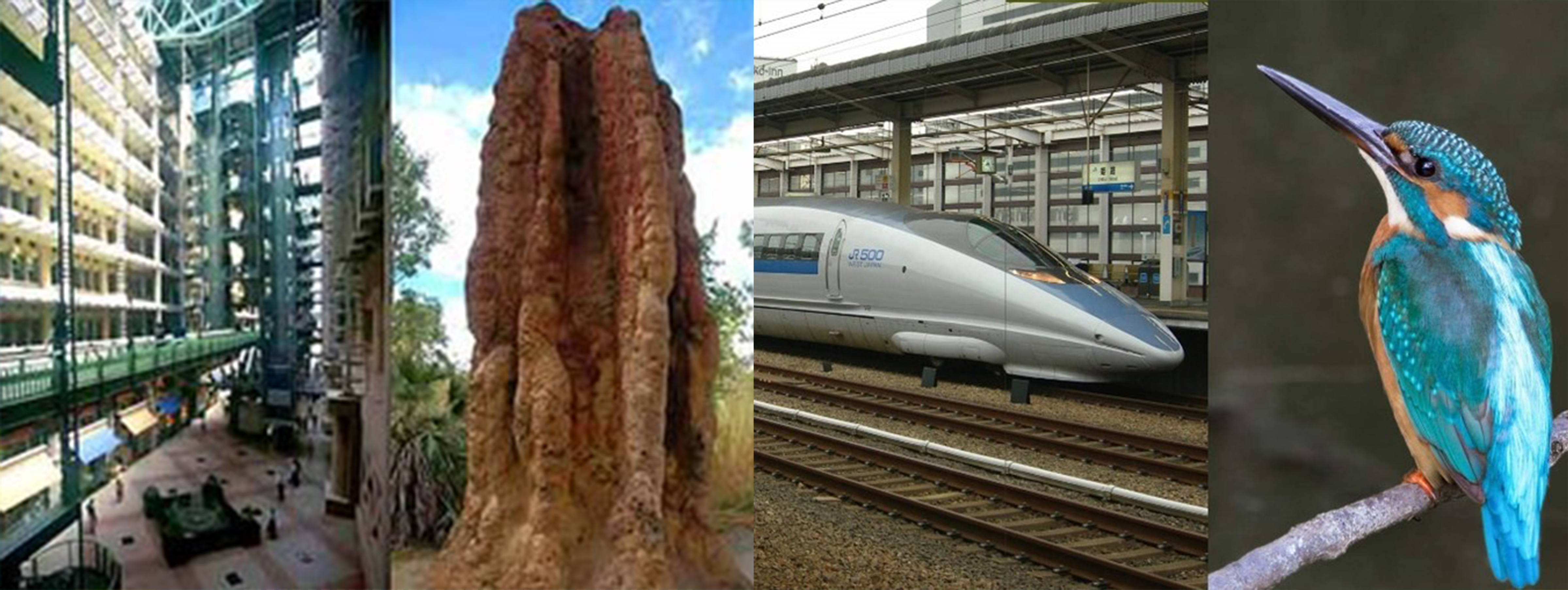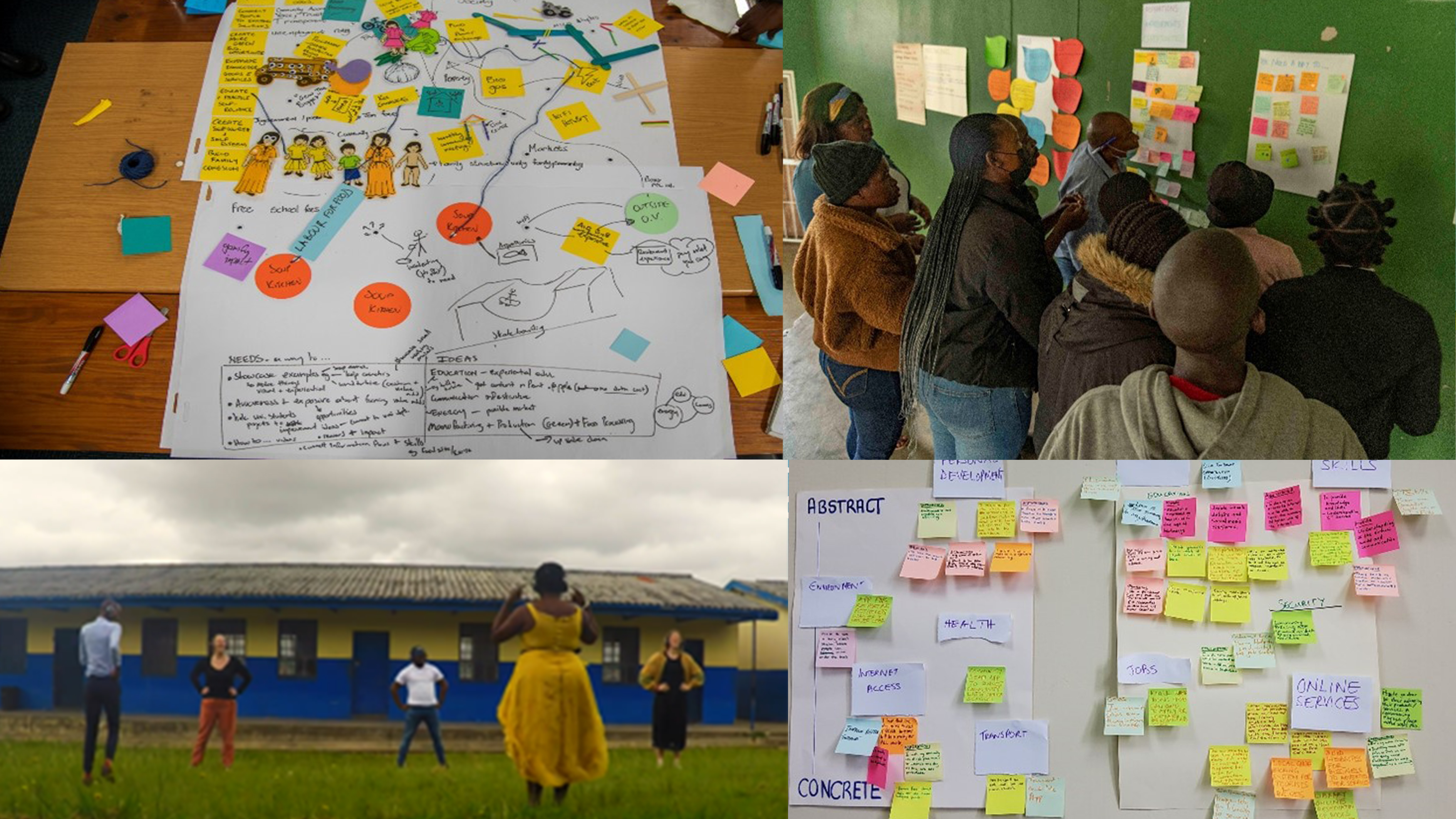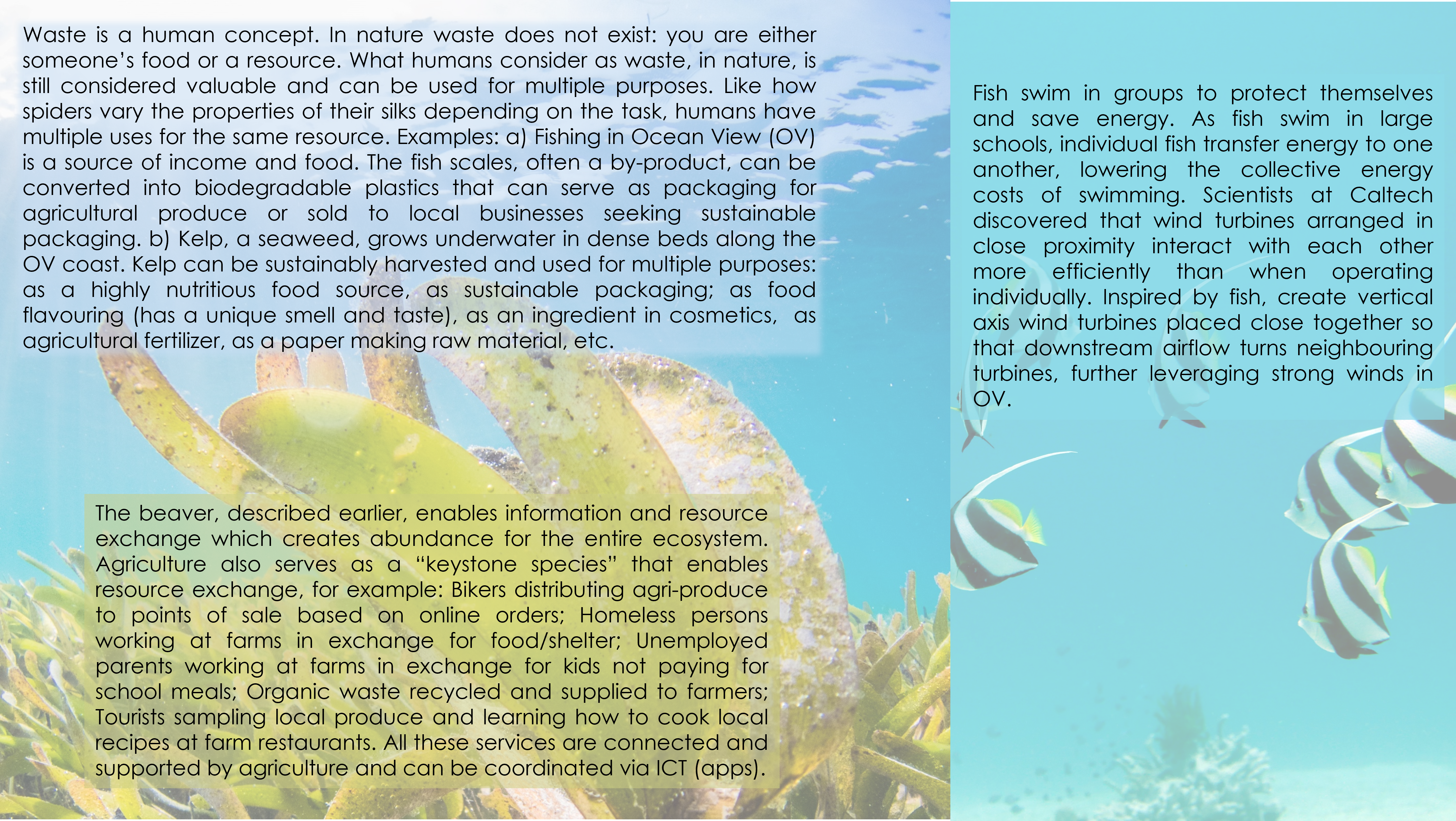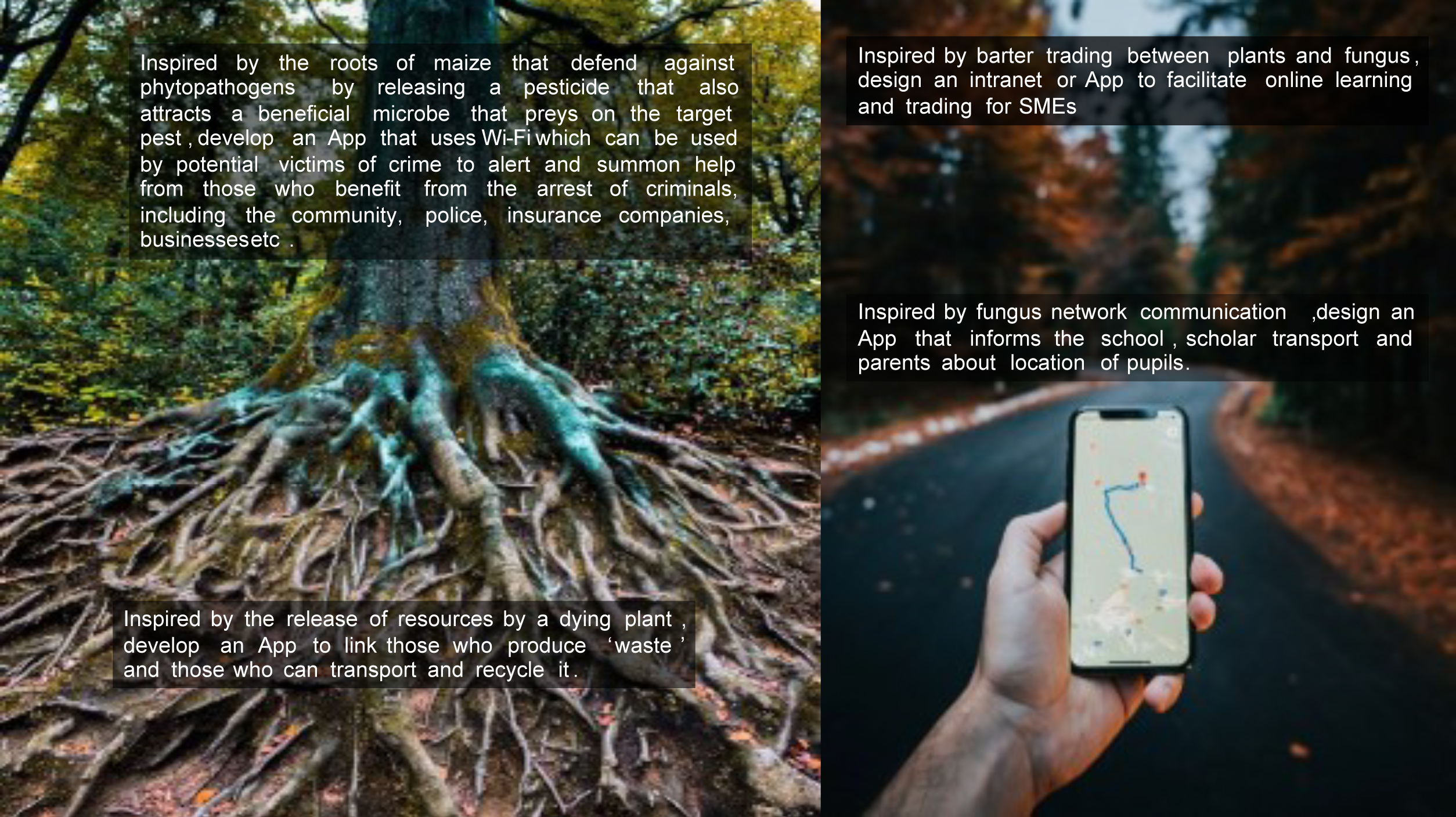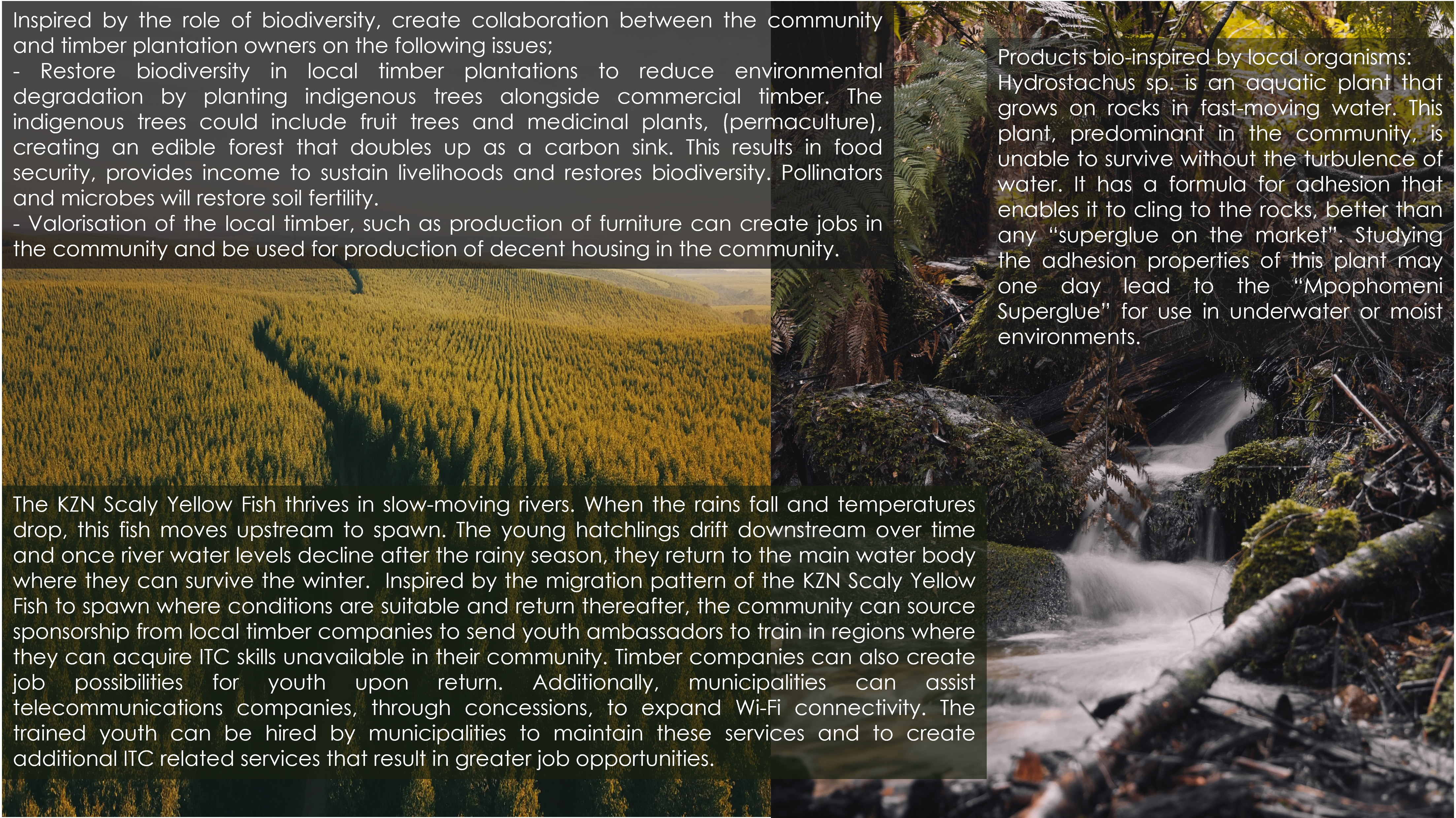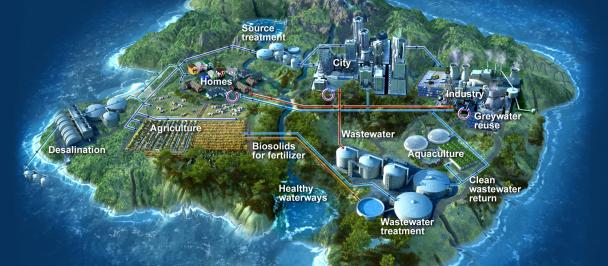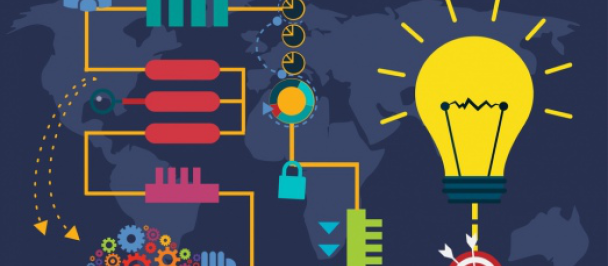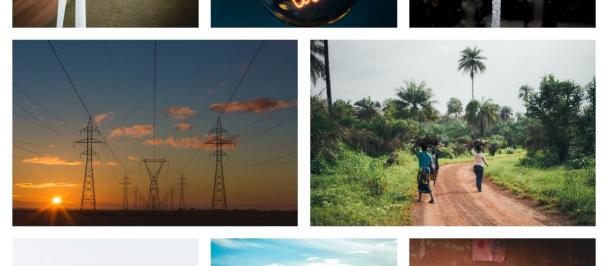“In biology, you learn about nature, and our species tend to spend a lot of time learning about nature, while biomimicry turns the lens around and says: what can I learn from the natural world?. So, in summary, (biomimicry) is the practice of learning from nature in order to emulate it”.The Late Claire Janisch, Founding Director of BiomimicrySA
Why emulate nature? Nature has evolved over millions of years in order to continually support life and its various ecosystems. Having stood the test of time, natural systems hold genius knowledge of what it takes and how to maintain life without depleting the environment which sustains it. With the world facing climate change, depleting resources, and embarking on the 4th industrial revolution, it becomes important, now more than ever, to identify alternate methods of “being” – methods that promote living in harmony with our environment.
Biomimicry concepts have over recent years translated into tangible products and solutions for everyday living. For example, the Eastgate Mall in Zimbabwe was constructed to emulate the cooling mechanisms of termite mounds [1], and Japan’s bullet trains have been designed to mimic the Kingfisher bird
[1], and Japan’s bullet trains have been designed to mimic the Kingfisher bird [2].
[2].
Let’s get back to the fungi, beavers and elephants 😊
An ecosystem is a community of organisms such as microbes, plants, insects, birds and animals that interact with one another. These organisms depend on each other to reproduce, survive, and thrive. For example, a beaver builds a dam across a river, and plants grow on the riverbank on either side of the dam. The dam protects the plants from strong winds and floods. The plants protect the beaver from predators. Furthermore, the beaver helps the plants as it builds a lodge on the bank where it stores food. The lodge provides shelter for birds that feed on insects. In some cases, the insects feed on the nectar from some of the plants. All these plants and animals provide a home to several other insects that feed on the plants and one another. These insects excrete waste which collects at the base of the plants and helps fertilise them. The dead trees are used as food by insects, birds and other animals. In more complex ecosystems there are also larger animals that feed on both plants and insects. In return, these larger animals help to distribute the seeds of the plants far and wide. In the above example, the beaver is considered a keystone species, as its presence allows for information and resource exchange that create abundance for the entire ecosystem. By ensuring the survival of keystone species, benefits cascade to the entire ecosystem, keeping it in balance.
Beaver and a beaver dam
Keystone species also exist in socio-technical systems in some shape or form. Identifying and leveraging them has the power to create positive systemic shifts that can result in groundbreaking opportunities. To this end, UNDP South Africa and BiomimicrySA partnered to commission a study to unearth innovative and sustainable socio-economic opportunities by applying the concepts of biomimicry and design thinking. In particular, we chose to undertake this study in four communities in South Africa where UNDP and the Council for Scientific and Industrial Research are presently rolling-out low-cost internet through the Television WhiteSpace (TVWS) Technology. This study was conducted alongside the internet release project to promote environmental sustainability in the 4th Industrial Revolution (4IR), where often solutions/products can have adverse effects on the environment (considering the toxicity of e-waste or inefficient energy consumption).
Many aspects of 4IR already incorporate biomimicry - artificial Intelligence copies human intelligence; drones are based on nature's animals of flight; the Internet of Things (IoT) and sensors draw inspiration from human senses and its connectivity through the central nervous system. However, at a basic level there is still a need to ensure the 4IR is sustainable – for all forms of life. Given that the 4th Industrial Revolution is only getting started, the opportunity (and responsibility) exists now to ensure it protects the planet rather than destroys it.
By employing biomimicry and design thinking methodologies to uncover new socio-economic opportunities resulting from improved internet connectivity, communities are empowered to develop solutions that are empathetic to all life forms, environmentally friendly, socially sustainable and regenerative. In this way, emergent opportunities will empower locals to reap maximum benefits from improved internet access, but also promote social and environmental sustainability – addressing many of the UN Sustainable Development Goals.
The study to unearth socio-economic opportunities through biomimicry and design thinking commenced with several community engagements and consultations in Mpophomeni (KwaZulu-Natal), Mdantsane (Eastern Cape), Ocean View (Western Cape), and Botshabelo (Free State), with the aim to support locals in unearthing challenges and opportunities which if addressed, could improve their community’s socioeconomic status by fostering growth and development. In parallel, Biomimicry experts undertook ecological analyses within the four provinces, assessing the local environment to identify “keystone species” which could inspire solutions to the identified challenges. The challenges/opportunities prioritised by the communities were then framed as questions to nature to inspire the creation of environmentally conscious solutions.
Community Engagements
The infographic below summarises the immediate findings:
After posing the various challenges to nature, here’s what nature had to say!
The Eastern Cape
The Mdantsane township in the Eastern Cape is sprawled across a hilly landscape of terrestrial ‘peninsulas’, that fall away to steep vegetated ravines, with a thickly covered mix of coastal forest and thicket vegetation. The present-day landscape is dominated by urban infrastructure. Mdantsane is situated within the Thicket Biome, characterised by a rainforest flora. Thicket traditionally supports rich animal life and large animals, such as elephants, which are an essential - keystone - part of the workings of the thicket. Species such as the elephant have been – and still are – important ecosystem engineers. The elephant creates and maintains the environment in which other species live. For example, they dig holes, plough the ground, remove trees, and turn over rocks, creating habitats for other organisms. Elephants help in seed dispersal and germination, regeneration of woodland and damaged grasslands. They regulate bush fires and control populations of other animals.
How elephants inspire solutions to Mdantsane’ s challenges
The Western Cape
The story of Ocean View starts with the story of the Cape Peninsular. Over the past 5 million years, the Peninsular has been a series of islands, a giant dune-scape, a peninsular and a glacier site. With the combined drop in sea levels and the concurrent emergence of a sandy bridge at this point (what is now the Cape Flats), the Peninsular connected with the ‘mainland’ of Africa. The ocean currents which split close to the southernmost point of Africa, especially the fauna-rich cold Benguela Current were affected by this process as natural bays, such as Hout Bay, formed and became the socio-economic lifeblood (and tourism attraction) of the Peninsular, including Ocean View. Another important environmental aspect of Ocean View is the prevailing wind - the strong and dry Southeaster and the surrounding biodiverse fynbos and Strandveld floral regions. Fynbos is a small belt of natural shrubland and Strandveld is a beach scrub that covers and stabilises sand dunes on the beaches. All these natural characteristics provide rich inspiration for solutions to the various issues facing this culturally diverse community.
How fish, beavers and spiders inspire solutions to Ocean View’s challenges
The Free State
Botshabelo generally appears flat, vast and expansive, lying 1400-1450m above sea level and supporting a range of small and medium-size animals. The township is bisected by the seasonal Klein Modder River, a fork of the larger Modder River which feeds the Rustfontein Dam and Nature Reserve. Botshabelo falls within the Grassland Biome. The present-day vegetation surrounding Botshabelo is mostly a degraded grassland, and intentionally planted native and exotic shade-bearing trees or hedging shrubs. The Free State Biodiversity Plan (2016) classifies large parts of Botshabelo as an Ecosystem Support Area (an area that supports the ecological functioning of a protected area).
Aeons before the World Wide Web there was the Wood-Wide Web mediated by the Mycorrhizal fungus, which is an underground keystone species. Mycorrhizae aids in water and mineral nutrient absorption from the soil in exchange for sugars and inorganic nutrients from the host. The Mycorrhizal fungus enables ‘tree talk' - communication amongst plants, analogous to the role of modern-day internet. Communication happens through the transfer of signals and other environmental cues that influence plant adaptive behaviour and impacts the entire forest ecosystem. When a tree is under attack it sends chemical signals through the air and the underground fungal network to other plants, warning them to raise their defences. The roots of maize defend against phytopathogens by releasing a pesticide which also attracts a beneficial microbe that preys on the target pest. The roots fungal network also distributes resources emanating from dead plants to neighbouring plants and allows mature trees to send nutrients to seedlings lying in shaded areas that are unable to photosynthesise.
How plant roots and fungi inspire solutions to Botshabelo’s challenges
KwaZulu-Natal
Mpophomeni is located on a series of hillslopes, is bounded by nature on 3 sides and situated a little distance from the nearest town. To the north, is it bordered by the provincial road, the Midmar Dam and the provincial nature reserve; to the west by commercial forestry plantations; to the east by peri-urban agricultural and residential smallholdings; and to the south by indigenous forest which separates it from a band of settlements. As a result, any impacts and challenges created within and affecting Mpophomeni have broader-reaching ecological impacts. The flip-side is that Mpophomeni should have higher biodiversity than most other peri-urban areas of KZN. When looking at inspiration from nature to address the many challenges in Mpophomeni, the high biodiversity potential and endemism is important to incorporate. The majority of land in the Midlands has always been ideal for farming.
Since 1950 timber has been more profitable than dairy or beef farming and the trend towards afforestation had accelerated. The climate of the area is exceptionally favourable for timber and hence paper mill giants have invested in extensive timber plantations. Much of the region has now been converted into timber monoculture which also had a large effect on the hydrological integrity of the region. Timber plantations use large amounts of water, reducing stream flow and due to pollutants, both from industry, agriculture, and burgeoning human population, water resource degradation is prevalent. Mpophomeni’s water story is based on the uMngeni water Catchment, within which is situated, and which supplies several key dams that supply major towns and cities. Pollution of the catchment is raising concern about the water quality in one of the country’s most important dams.
Timber monoculture is the creation of an ecosystem with a single species of tree. In Mpophomeni timber, monoculture is a result of humans cutting indigenous trees and planting a single species for commercial timber. This practice destroys the ecosystem and culminates in the loss of biodiversity and soil degradation. Furthermore, monoculture lacks resilience provided by diversity and an attack by some beetles or disease can affect the entire plantation. Preserving biodiversity is important to maintain ecosystem balance.
Hence, nature has given us many solutions to the various challenges identified. The next phase of this project will prototype and pilot some of them. Interestingly, I find myself concluding this blog on a flight to Cape Town to attend a summit on Digitisation and 4IR. With the vast green landscape below me and the gaping blue openness alongside me, I am reminded that to succeed in the digital era, we best be continually asking ourselves “what will nature do”?
If you’re inspired by this nature-led journey, reach out to me at klariska.moodley@undp.org.
In memory of the late Claire Janisch, founding director of BiomimicrySA
References
[1] https://inhabitat.com/building-modelled-on-termites-eastgate-centre-in-zimbabwe/
[3] https://en.wikipedia.org/wiki/Beaver_dam#/media/File:AlgonquinBeaverDam.JPG

 Locations
Locations
